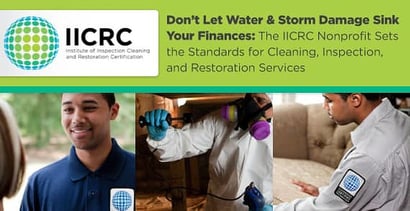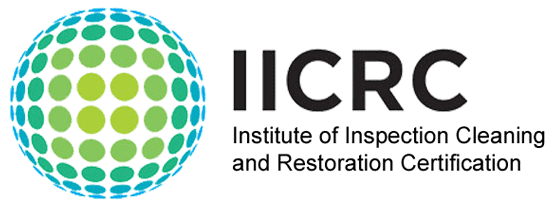

In a Nutshell: Water damage can strike unexpectedly, causing costly damage to homes and businesses. Many people don’t face water damage in time, nor do they use proper equipment to get rid of the water or the subsequent mold that develops. The best course of action to ensure your family avoids health problems following water damage to your home is turning to an IICRC-certified professional. The Institute of Inspection, Cleaning, and Restoration Certification (IICRC) sets global standards and provides 27 certifications for people in the cleaning and restoration business. With a presence in more than 25 countries, the IICRC also provides consumers with educational resources on restoration — so they can repair water-related damage themselves — without breaking the bank, but also doing it the safest way possible.
Water damage from flooding and storms can wreak havoc on a family’s home and finances. The average cost of water removal alone is $2,700. Cleanup and restoration add thousands more to the bill, and a foot of flood damage repair can cost nearly $20,000. While the average water damage insurance claim is $7,500, uninsured people are looking at more staggering out-of-pocket costs.
So, people try to cut corners. One of the first mistakes they make is not facing the scope of the problem. When they procrastinate, the water damage can actually worsen, penetrating building materials, and ultimately also driving up the cost of restoration. When people do seek help, they don’t look for certified experts.
Instead, people should reach out to and rely on certified experts right away. The IICRC is an organization dedicated to setting industry standards — and training experts — in inspection, cleaning, and restoration of damaged properties. Its Clean Trust logo has become a symbol of confidence between certified technicians and customers.

For over 45 years, the organization has been helping people to train and certify experts to do the hands-on hard work that goes into cleaning up the mess left by water damage.
Jeff Bishop, a Director of IICRC, is a second-generation restoration expert. He sums up the genesis of the problem that the nonprofit IICRC helps resolve. “It happens frequently when there is wholesale flooding … people have hardly anywhere to turn but to rely on themselves, which can jeopardize the health and safety of their families,” Jeff said.
Although there are a few other organizations similar to IICRC, such as the Restoration Industry Association (RIA), IICRC sets the standard for the training and certification of experts.
“In the industry, there is no specific regulation that governs how restoration can be performed except ANSI/IICRC S500,” also known as the Standard and Reference Guide for Professional Water Damage Restoration, Jeff said.
IICRC’s Rigorous Standards & Values Ensure Quality Service
The IICRC provides three certification tracks for water damage restorers. The first and most basic involves attending a three-day course and passing an exam with a grade of 75% or higher, Jeff explained.
The second level certifies someone to be a journeyman water restorer. The student must take three courses: in water damage restoration, carpet cleaning, and carpet repair and reinstallation, Jeff added. Students must also have one year of work experience since the date of their first certification.
The third and highest level of certification is for the master water restorer, Jeff continued. The student takes five courses, including courses in structural drying and microbial remediation, all of which involve 13 days of instruction and five exams. “This is your best bet, if someone needs their property restored,” Jeff said. “The master water restorer has to have three years of experience since the date of their first certification.”
Jeff told us the IICRC standards specify three Categories of water, which plumbers usually refer to as “clean, gray, and black.” Clean, or Category 1 water, is clean at the releasing source and safe for human consumption. Category 2, or “gray water,” is somewhat contaminated — either from mixing with soil or from exposure to contamination in walls or on floors inside a building or home. Category 2 water can cause discomfort or sickness in humans.
Category 3 water, “black,” is the most dangerous. If ingested, it can cause disease, and even death in rare cases. It’s caused by storm surges, sewage backups, and flood water, which can pick up soil bacteria, agricultural products, decaying animals or insects, and animal droppings along the way, Jeff said. “As it flows across the ground, it is presumed to be unsanitary,” he said. “Eventually, flood water trapped in structural cavities causes bacteria to amplify and produce malodor.”
IICRC has 27 certification courses in three areas: inspection, cleaning, and restoration. Students can get certified in cleaning and inspecting various floor surfaces and furniture coverings, including upholstery and fabric; leather; stone and ceramic; and carpet and wood flooring.
How Uninsured Consumers Can Minimize Water Damage
In the aftermath of Hurricane Katrina in 2005, Jeff prepared several tips for consumers on minimizing water damage after a flood. The exhaustive list begins by prioritizing safety. People should wear protective gloves, respirators, and splash goggles to minimize direct contact or inhalation of microorganisms in the water. They should also open the windows of a flood-damaged structure to completely air it out, and remove any electrical shock hazards.
When removing debris, they should use shovels or rakes, and sanitize those tools when they are done using them. They should also remove wall closure materials (drywall, paneling) and insulation materials exposed during wall removal, leaving only materials that are durable and minimally porous. Materials that trap unsanitary water and should be removed include carpet, cushion, pad, felt, and sheet vinyl, along with laminate flooring. These materials are prone to absorb water, causing odor which promotes rapid microbial growth, potentially leading to health problems.

The IICRC goes beyond certification to help people understand how to safeguard their homes from damage.
Some of Jeff’s other tips involve the collaboration of a certified professional who can provide specialized services such as flushing contaminants from salvageable surfaces with pressure washing, and immediately vacuuming up the rinse water, applying biocides (which kills microorganisms) to salvageable surfaces, and using specialized fans and dehumidifiers to dry out structures. Copies of specific consumer self-restoration steps for flooding can be obtained by accessing the IICRC web site.
Over 55,000 Active Technicians Have Been Certified by IICRC
When consumers turn to an IICRC-certified professional, they know they’re getting an expert who can help restore their property and prevent their families from the potential harmful effects of water damage.
With 45 years of experience in setting the industry standards, the IICRC has become a trusted name in the field of inspection, cleaning, and restoration services. The organization currently has more than 55,000 active certified technicians and more than 5,500 certified firms around the world.
Headquartered in Las Vegas, Nevada, the organization is managed by a Board of Directors that is comprised of 15 directors, who prioritize maintaining the IICRC’s reputation of certifying professionals who adhere to five key values of respect, responsibility, integrity, excellence, and being experts in their trade.
IICRC also has strategic partnerships with nine similar organizations throughout the world. It is constantly expanding its global and national network through conferences and symposiums. In August, it will host a technical conference, along with a recently added science symposium, in Big Sky, Montana. The microbiome is the keynote topic of the symposium, which is entitled “The Microbiome and its impact on Cleaning, Contracting, and the Restoration Sciences.”
Advertiser Disclosure
BadCredit.org is a free online resource that offers valuable content and comparison services to users. To keep this resource 100% free for users, we receive advertising compensation from the financial products listed on this page. Along with key review factors, this compensation may impact how and where products appear on the page (including, for example, the order in which they appear). BadCredit.org does not include listings for all financial products.
Our Editorial Review Policy
Our site is committed to publishing independent, accurate content guided by strict editorial guidelines. Before articles and reviews are published on our site, they undergo a thorough review process performed by a team of independent editors and subject-matter experts to ensure the content’s accuracy, timeliness, and impartiality. Our editorial team is separate and independent of our site’s advertisers, and the opinions they express on our site are their own. To read more about our team members and their editorial backgrounds, please visit our site’s About page.




